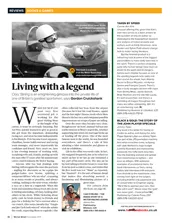
Books 2
Ciao Stirling – the inside story of a motor racing legend Valerie Pirie, Published by Biteback, £20. ISBN 978-1-785-9063-9 When you’re 17 and your very first secretarial job is working…
I thoroughly enjoyed every article in the June issues of Motor Sport, featuring the recently departed Stirling Moss. Yours is a very comprehensive tribute to a figure who deserves every good word. What a wonderful driver and ambassador. I saw Moss drive at the Sebring 12-hour race in 1962 – his last major race before his career-ending crash. He was co-driving a Ferrari 250 TR sharknose sports-racer with Innes Ireland.
They should easily have won the race, except that they were disqualified for refuelling two laps too early. Their disqualification took place many hours after some unwitting marshal unsealed the fuel filler and a similarly unwitting mechanic, noticing the broken seal and assuming that this meant the car should be refuelled, did just that. The shouting match between Moss, Ireland and the marshal who informed them of their disqualification, captured on a Riverside recording of that race, is something to behold. I later met Moss in Modena in 2003 at a re-running of the Mille Miglia (then run as a rally event with period-appropriate cars). We had a marvellous chat. I told him that I had seen him race at Sebring in 1962.
He still remembered the injustice and disappointment of that race. But he also took the occasion to tell me that he had won the race in 1954 in an OSCA and that one of the prizes was some unusable swampland in south Florida. Ever the salesman, he asked if I would like to buy it… He was, and still is, an unforgettable character.

And you thought multi-seat Formula 1 cars were recent… Ginther picks up hitch-hikers at Charade
Regarding your Great Read choice on your website about the 1965 French Grand Prix. I borrowed my father’s MG1100 that year and went to Le Mans with a friend called Roger Warburton. Then we headed south to the French GP. We decided to stay at a village called Pontgibaud which was on the 1905 Gordon Bennett circuit. It turned out that Jenks was staying in the other (more expensive) hotel in the village on the other side of the main square. We introduced ourselves and spent many happy hours sitting drinking and hearing loads of stories. That was the start of a friendship that lasted until he passed away.
I attach a photo of Ginther in the Honda giving Innes Ireland and Jo Bonnier a ride back to the pits in practice. Not allowed today!
I’m sure the statement ‘It wasn’t until TWR/JaguarSport and the XJR-15 in 1990 that a full resin-composite structure was attempted again for a production road-legal car’ was an editorial ploy to check if your older readers were awake, but really… I can’t remember them all but the Rochdale Olympic , the Lotus-inspired Clan Crusader and the Mini Marcos spring to mind. It was the success of the Mini Marcos’ successor, the Midas, which lead to its producer Harold Dermott being employed to help manufacture the McLaren F1. But let’s not forget the 1964 Marcos Coupé, a true composite car elegantly combining ply and glass fibre with sensible mechanical components – an Elite for grown ups. Well, anyone taller than Colin Chapman! Incidentally the Mini Marcos is still available for sale.
Further to the letter in the August 2020 edition of Motor Sport from Geoff Wyler about resin-composite structure road legal cars I would like to remind readers of another one – the Clan Crusader, with its rear-mounted 875cc Hillman Imp engine. I owned one for 10 years. I bought it second-hand and it was my everyday road car. I put over 100,000 miles on the clock and then sold it for more than I paid for it! Wish I still had it now. Unfortunately we don’t seem to see them on the road any more. They became popular for sprinting and hillclimbing in the early 2000s, but are not around for that now.
As I attended the 1975 Monaco Grand Prix ( don’t let anyone tell you it does not rain on the Cote D’Azure ) it was great to see the Niki Lauda Ferrari 312T feature in the August issue. These days I watch video of Formula Junior, Formula 2 and Formula 1 from the early to mid 1970s. Real racing cars, and you can tell the make by the shape of them. I stopped watching Formula 1 in 1995 when the V10s finished, so I am pleased to say I have not watched the championship years of Jenson, Lewis or Sebastian. The drivers are okay but aesthetically and soundwise, along with Formula E, the current V6 turbos are rubbish. When is Ross Brawn going to fix the problem? It is not going away. Innovation has taken a back seat.
That was an excellent article on Lauda’s Ferrari 312T. Your subheading against the photograph on page 67 is puzzling, though. The car appears to be mostly “Lauda’s Ferrari”, but with a 1977-style upper body/cockpit surround/engine air intake. The latter were not as flared as those on the 1976 312T2. Lauda’s 1975 race number 12 is correct on the nose section, but the 12 on the 1977 upper body was allocated to Carlos Reutemann, who replaced the late great Clay Regazzoni for the 1977 season. Those excellent pictures illustrating your article clearly show the complete form of the 1975 car, so presumably the real part was somewhere under those blankets!